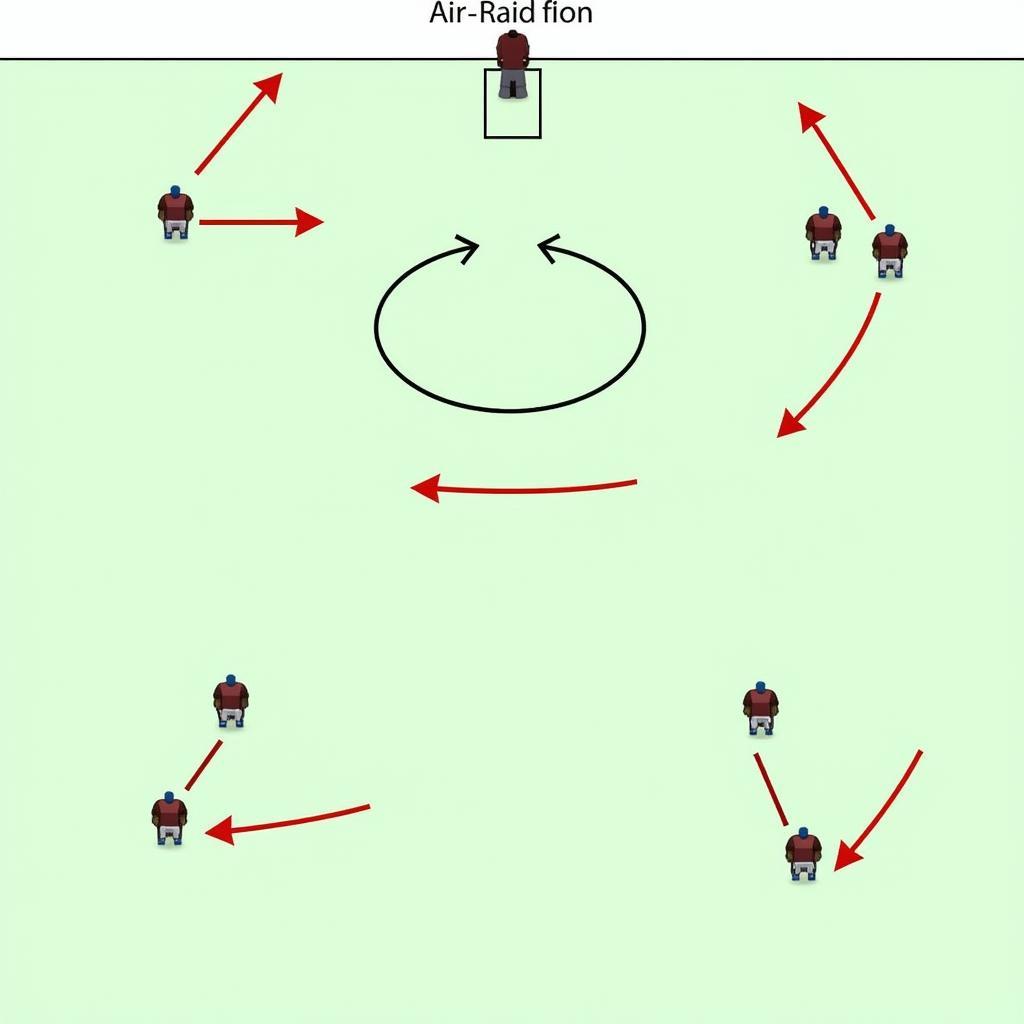Mastering Air Raid Offense Formations: A Deep Dive
October 27, 2024Air Raid Offense Formations are designed to spread the field horizontally and vertically, forcing defenses to cover every inch of the gridiron. This offensive strategy relies heavily on the passing game, utilizing a variety of formations and route combinations to create mismatches and exploit defensive vulnerabilities.
 Wide receiver routes in an air raid offense
Wide receiver routes in an air raid offense
The Philosophy of the Air Raid
The core principle of the air raid offense is to dictate the terms of engagement to the defense. By spreading the field, offenses force defenses to make difficult choices in coverage. This creates opportunities for quick passes, deep shots, and running lanes for the quarterback or running backs. The air raid offense prioritizes speed, precision, and the ability to read defenses quickly and decisively.
Key Elements of Air Raid Offense Formations
Several key elements define air raid offense formations:
- Spread Formations: Four or even five wide receivers are common, stretching the field horizontally and creating space for receivers to operate.
- Shotgun Formation: The quarterback lines up several yards behind the center, allowing for a wider field of vision and quicker passing opportunities.
- Simplified Reads: The air raid offense often utilizes simple route concepts and reads for the quarterback, enabling quick decisions and throws.
- High Tempo: A fast-paced, no-huddle approach keeps defenses off-balance and limits their ability to substitute players or make adjustments.
 Quarterback reading defensive coverage in an air raid offense
Quarterback reading defensive coverage in an air raid offense
Common Air Raid Formations
- Four Verticals: Four receivers run deep routes, stretching the field vertically and challenging the safeties.
- Mesh: Two receivers run crossing routes at different depths, creating traffic for defenders and potential pick plays.
- Y-Cross: A combination of deep and intermediate routes, designed to attack different areas of the field and create confusion for the defense.
- Stick: Receivers run quick out routes to the sidelines, providing the quarterback with high-percentage throws and opportunities for yards after the catch.
Advantages and Disadvantages of the Air Raid
Like any offensive system, the air raid offense has its strengths and weaknesses:
Advantages:
- High Scoring Potential: The emphasis on the passing game and quick strikes can lead to explosive plays and high point totals.
- Difficult to Defend: The spread formations and multiple route combinations create challenges for opposing defenses.
- Quarterback Development: The air raid system emphasizes quick decision-making, reading defenses, and accurate passing.
Disadvantages:
- Predictability: The heavy reliance on the pass can make the offense one-dimensional if not balanced effectively.
- Weather Dependent: Strong winds or rainy conditions can hinder the passing game.
- Protection Issues: The spread formations can leave the quarterback vulnerable to sacks if the offensive line struggles.
The Evolution of the Air Raid Offense
The air raid offense has evolved significantly since its inception. Modern variations incorporate run-pass options (RPOs), pre-snap motion, and a greater emphasis on tempo and misdirection.
Conclusion
The air raid offense, with its emphasis on spreading the field and attacking through the air, has become a potent offensive strategy in football. While it’s not without its drawbacks, the air raid’s ability to generate explosive plays and put points on the board makes it a formidable offensive system in the right hands. As the game continues to evolve, expect to see further innovations and adaptations of the air raid offense in the future.
FAQs about Air Raid Offense Formations
1. What is the main goal of the air raid offense?
The primary objective is to spread the field, create mismatches, and exploit defensive vulnerabilities through a pass-heavy attack.
2. What are the key characteristics of an air raid offense?
It typically involves spread formations, a shotgun quarterback, simplified reads, and a high-tempo approach.
3. Is the air raid offense only about passing?
While it emphasizes the passing game, successful air raid offenses incorporate running plays strategically to keep defenses honest.
4. What are some common air raid formations?
Popular formations include Four Verticals, Mesh, Y-Cross, and Stick.
5. What are the advantages of using an air raid offense?
Advantages include high scoring potential, difficulty for defenses to counter, and enhanced quarterback development.
6. What are some disadvantages of the air raid offense?
Disadvantages include potential predictability, weather dependency, and vulnerability to sacks.
7. How has the air raid offense evolved over time?
Modern variations often integrate run-pass options, pre-snap motion, and a greater focus on tempo and misdirection.
Need Help? Contact us at Phone Number: 0915117113, Email: [email protected] Or visit us at: To 3 Kp Binh An, Phu Thuong, Viet Nam, Binh Phuoc 830000, Vietnam. Our customer support team is available 24/7.